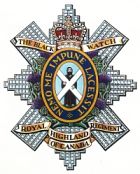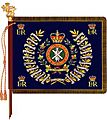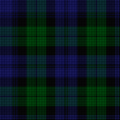Black Watch (Royal Highland Regiment) of Canada facts for kids
Quick facts for kids The Black Watch (Royal Highland Regiment) of Canada |
|
|---|---|

Cap badge of the regiment
|
|
| Active | 31 January 1862 – present |
| Country | Province of Canada (1862–1867) Canada (1867–present) |
| Branch | Canadian Army |
| Type | Line infantry |
| Role | Light role |
| Size | Battalion |
| Part of | 34 Canadian Brigade Group |
| Garrison/HQ | Black Watch Armoury, 2067, rue Bleury, Montreal, Quebec |
| Motto(s) | Latin: Nemo me impune lacessit, lit. 'No one provokes me with impunity' |
| March | Quick: "Hielan' Laddie" Slow: "The Red Hackle" |
| Engagements | Second Boer War First World War Second World War War in Afghanistan |
| Battle honours | See #Battle honours |
| Commanders | |
| Colonel-in-chief | Charles III |
| Honorary Colonel | Colonel Bruce Bolton, MMM, CD |
| Honorary Lieutenant-Colonel | Lieutenant-Colonel Jonathan Birks |
| Current Commander | Lieutenant-Colonel J.B.F. Roy, CD |
| Regimental Sergeant Major | Chief Warrant Officer F. Mamen, CD |
| Insignia | |
| Hackle | Red |
| Tartan | Black Watch (Government 1) |
The Black Watch (Royal Highland Regiment) of Canada is a special army group in Canada. It's a reserve infantry regiment, which means its soldiers train part-time but can be called to serve full-time when needed. They are part of the Canadian Army and are based in Montreal, Quebec. This regiment is known as the oldest Canadian-Scottish Regiment. Their home, the Black Watch Armoury, became a National Historic Site in 2008.
Contents
A Look at Their History
The Black Watch regiment started in Montreal on January 31, 1862. At that time, it was called the 5th Battalion, Volunteer Militia Rifles of Canada. People in Canada were worried about the American Civil War happening nearby. So, the government allowed new army groups to form. Six Scottish leaders in Montreal each created a company of soldiers for the 5th Battalion.
Since then, thousands of Canadians have joined the Black Watch. They have served in many important events. This includes helping during the Fenian raids and fighting in both the First World War and Second World War. They also supported NATO missions in Europe and United Nations peacekeeping around the world. At home, they helped Canadians during the January 1998 North American ice storm and floods in Quebec in 2011, 2017, and 2019.
The regiment has a special connection to the Royal Family. Queen Elizabeth The Queen Mother was their colonel-in-chief from 1947 until she passed away in 2002. In 2004, King Charles III (who was then Prince of Wales) took on this important role.
How the Regiment's Name Changed
Over the years, the regiment's name changed several times. It started as the 5th Battalion, Volunteer Militia Rifles, Canada in 1862. It was later known as "The Royal Light Infantry of Montreal" and then "Royal Scots of Canada." In 1906, it became the "Royal Highlanders of Canada." Finally, in 1935, it was named The Black Watch (Royal Highland Regiment) of Canada.
In 1953, the regiment joined with two other Canadian Highland Battalions. These became the 1st and 2nd Battalions of The Black Watch. The original reserve part of the regiment became the 3rd Battalion. Later, in 1970, the 1st and 2nd Battalions were put into a special reserve list, and the main reserve battalion continued without a number.
Important Battles and Service
Early Service
The 5th Battalion, The Royal Light Infantry of Canada, was called to active duty in 1866 and 1870. They served on the South-Eastern border of Canada during the Fenian raids. These raids were attacks by Irish-American groups who wanted to help Ireland gain independence from Britain.
Boer War (South Africa)
The Black Watch regiment did not fight as a whole unit in the Boer War (1899-1902) in South Africa. However, many volunteers from the regiment joined other Canadian units to fight there.
First World War (1914-1918)
When the First World War began, parts of the regiment were called up for local protection duties. Several new battalions were formed from the regiment for overseas service:
- The 13th Battalion went to Great Britain in 1914 and then to France in 1915. They fought bravely in France and Flanders until the war ended.
- The 42nd Battalion also went to Great Britain in 1915 and then to France. They fought as part of the 3rd Canadian Division.
- The 73rd Battalion arrived in France in 1916. They fought until April 1917, when their soldiers were used to replace losses in other units.
Second World War (1939-1945)
The Black Watch played a very important role in the Second World War.
- The 1st Battalion was sent to Great Britain in 1940. They took part in the Dieppe Raid in 1942. In 1944, they landed in France and fought across North West Europe until the war ended.
- The 2nd Battalion served in Canada, helping with home defense.
The 1st Battalion of the Black Watch faced some of the toughest fighting. They suffered more casualties than any other Canadian infantry battalion in Northwest Europe.
- During the Battle of Verrières Ridge in July 1944, out of 325 men who started an attack, only 15 returned. The rest were killed or wounded.
- On October 13, 1944, a day known as "Black Friday" for the Black Watch, they launched an attack near Hoogerheide. All four company commanders were killed, and one company of 90 men was reduced to only four survivors.
After the Second World War
After the war, the regiment continued to serve. In the early 1950s, temporary companies were formed. Some soldiers joined the 1st Canadian Highland Battalion for service in Germany with NATO. Others joined the 2nd Canadian Highland Battalion for service in Korea with the United Nations.
The 2nd Battalion, led by Lt.-Col. R.M. Ross, served in Korea after the fighting stopped, from 1953 to 1954.
Allies Around the World
The Black Watch (Royal Highland Regiment) of Canada has a special connection with the Royal Regiment of Scotland in the United Kingdom. They are allies, meaning they share a bond and support each other.
Battle Honours
Battle honours are special awards given to military units for their bravery and success in battles. They are like a list of achievements. The Black Watch has many battle honours, which are shown on their regimental flags.
War of 1812
- CHÂTEAUGUAY
- DEFENCE OF CANADA – 1812–1815
South African War
- SOUTH AFRICA, 1899–1900
Second World War
- BOURGUÉBUS RIDGE
- Faubourg de Vaucelles
- Verrières Ridge
- FALAISE
- THE SCHELDT
- THE RHINELAND
- THE RHINE
- NORTH-WEST EUROPE, 1944–1945
War in Afghanistan
- AFGHANISTAN
Heroes of the Black Watch: Victoria Cross Winners
The Victoria Cross is the highest military award for bravery in the British Commonwealth. Several members of the Black Watch have received this incredible honour:
| Lance Corporal Frederick Fisher †
13th Battalion, Canadian Expeditionary Force St. Julien, Belgium April 23, 1915 |
| Corporal Herman James Good
13th Battalion, Canadian Expeditionary Force near Amiens, France August 8, 1918 |
| Private John Bernard Croak †
13th Battalion, Canadian Expeditionary Force Amiens, France August 8, 1918 |
| Private Thomas Dinesen
42nd Battalion, Canadian Expeditionary Force Parvillers (near Amiens), France August 12, 1918 |
| † - Awarded after the person died |
Pipes and Drums
The Black Watch of Canada Pipes and Drums is a very old and famous musical group. It is the oldest organized pipe band in North America and the Canadian Army. This band is officially part of the Black Watch regiment and is based in Montreal. They are known for being one of the top Canadian Forces bands. Their history goes back to the 42nd Battalion Royal Highlanders of Canada Pipes and Drums from the First World War.
Performances and Events
The Pipes and Drums have performed at many exciting events over the years. They have appeared on The Ed Sullivan Show and at many military tattoos and highland games across North America. They played at the United States Bicentennial celebration in 1976 and for the "Trooping the Colour" parade in London. They were the only foreign band to march in the parade celebrating the 200th birthday of the American Constitution. They also performed at Queen Elizabeth The Queen Mother's 90th and 100th birthday celebrations.
-
The Black Watch of Canada Pipes and Drums marching in the Montreal St. Patrick's Day Parade in 2017.
Regimental Traditions
The Black Watch has special traditions, especially with their clothing. The pipers (who play the bagpipes) wear the Royal Stewart tartan. This is the special plaid pattern of the current monarch. The drummers wear the Government tartan, which is also known as the Black Watch tartan because of its dark colour.
Cadet Corps Connection
Bishop's College School Cadet Corps #2 has been connected to the Royal Highland Regiment of Canada since 1936. Every May, two platoons from the Cadet Corps join the regiment to march in their Church Parade.
Regimental Music
A march and two-step song called Gallant Black Watch was written for the regiment. It was composed by Bert L. Billings and published around 1906.
See also
- Canadian-Scottish regiment
- Black Friday (1944)
- The Canadian Crown and the Canadian Forces
- List of Canadian organizations with royal patronage










